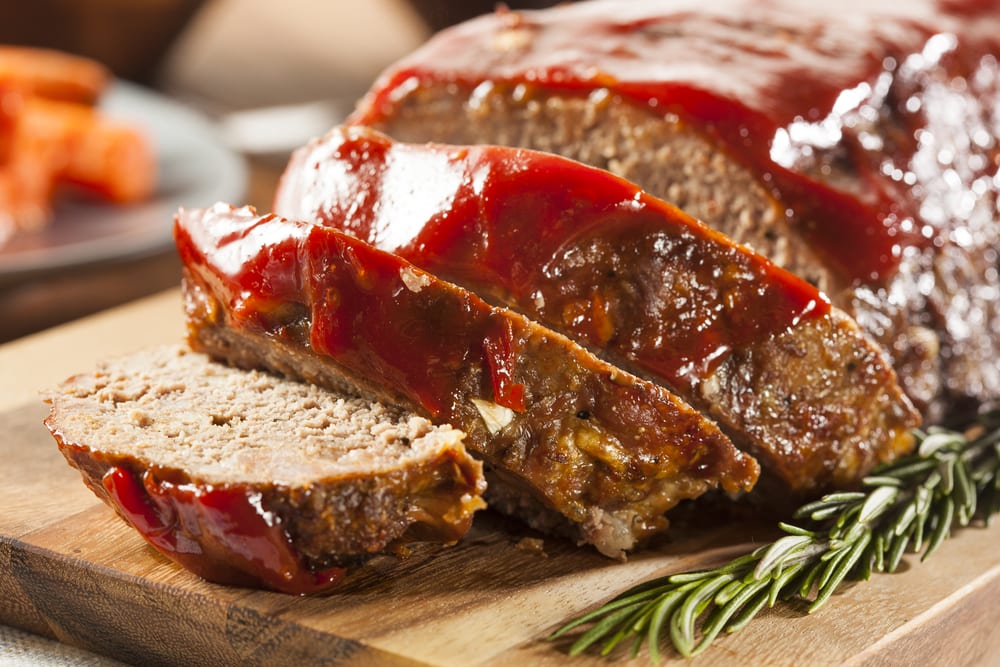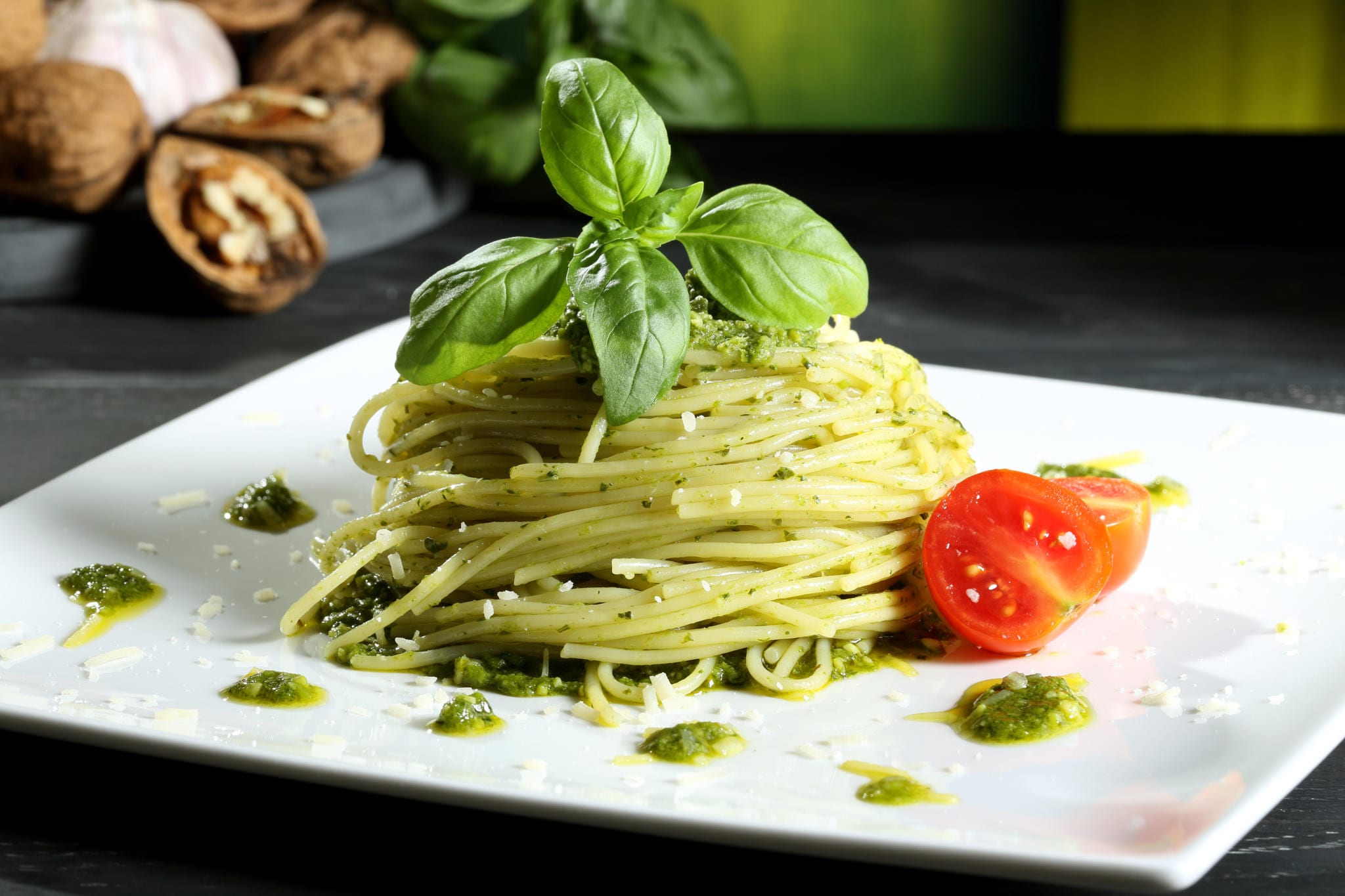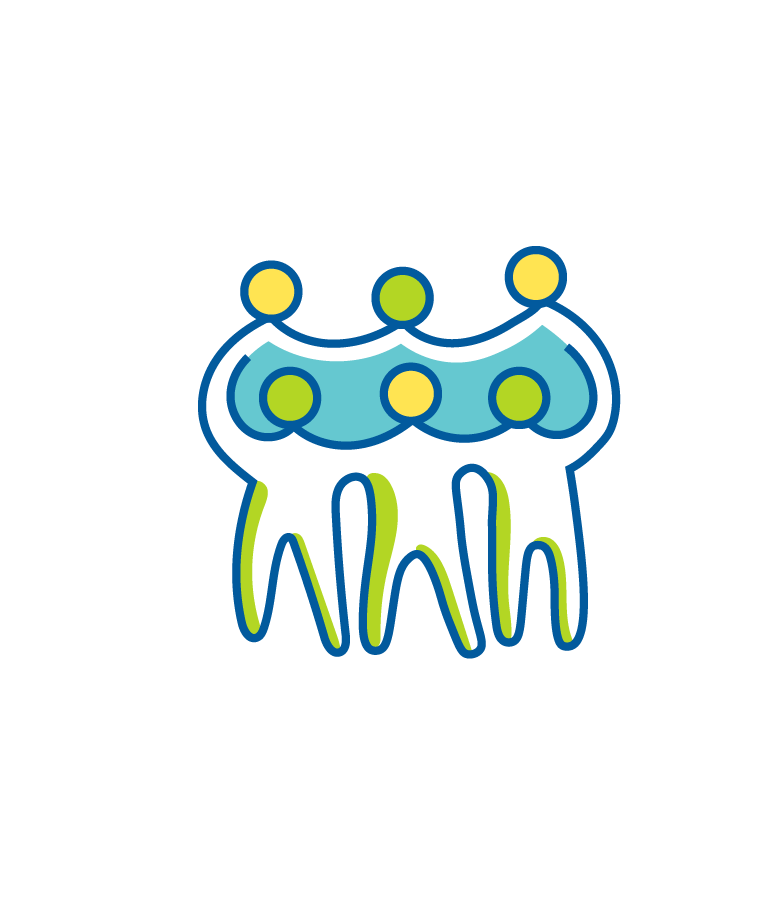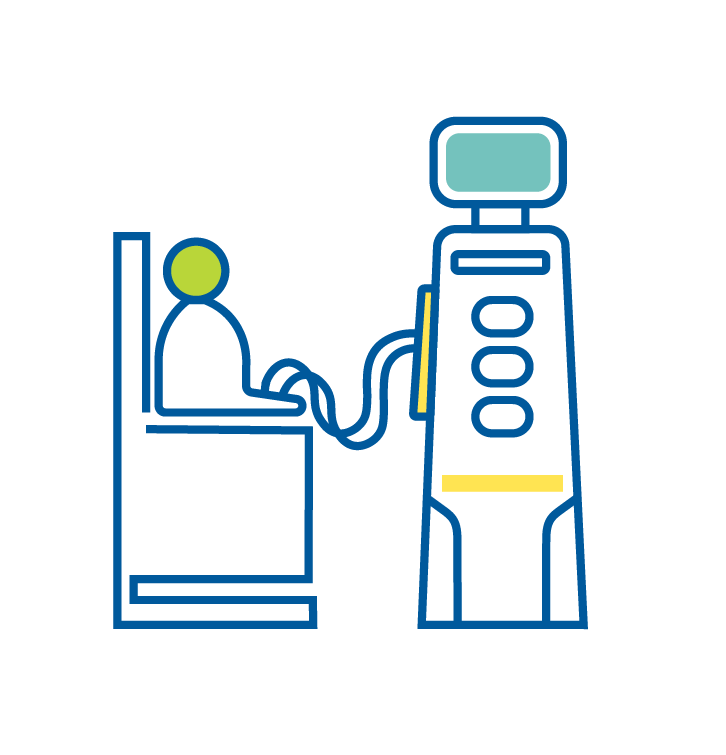Kidney failure (on dialysis)

Why do I need to change how I eat in kidney failure (on dialysis)?
Following a kidney-friendly food and fluid plan is very important for your health when you are in kidney failure and are on dialysis. In kidney failure, your kidneys cannot work the way healthy kidneys do to remove extra waste and fluid from your body. Dialysis helps do some of the work that your kidneys did when they were healthy, but it is not a replacement for healthy kidneys and can only do 10-15% of what healthy kidneys do.
Some waste and fluid may still build up in your body, especially between dialysis treatments. Over time, the extra waste and fluid in your blood can cause heart, bone and other health problems.
To feel and do your best on dialysis, you will need to change how you eat and drink. In kidney failure, you will need to eat more protein, while limiting fluid, salt, potassium and phosphorus. This will help to control your blood pressure and prevent fluid retention (when too much fluid builds up in your body) between dialysis sessions.
The kidney-friendly food and fluid plan you, your doctor and your dietitian come up with is a very important part of your treatment. Following this plan will help keep you in your best health.
How can I eat healthy in
kidney failure (on dialysis)?
Once you are on dialysis you will have a renal (kidney) dietitian as part of your care team. They will help you understand your new kidney-friendly food and fluid plan, as well as any changes they may need to make to it based on how well you are feeling and your lab results.
You will likely need to:

Eat more protein

Limit sodium (salt), potassium and phosphorus

Limit fluids

Protein

Limit sodium (salt), potassium and phosphorus

Fluid
Protein
Your body needs protein to build muscle, heal and stay healthy. When you are on dialysis, your protein needs are higher. Dialysis removes some of your body’s blood proteins, so you will need to eat more protein to help make up for the amount you lose during your dialysis treatments. These proteins are important to help your veins and arteries transport nutrients to the rest of your body.
Get your protein from lean protein sources:

Eggs

Chicken

Fish

Turkey
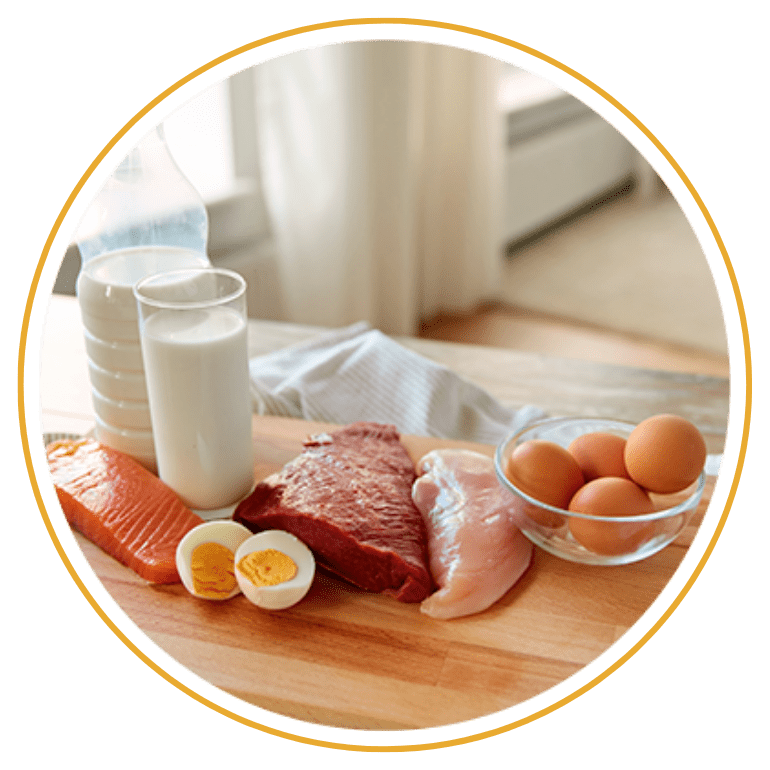

Quinoa

Beans

Soy products (tofu, edamame, tempeh, soy milk, etc.)
Lean protein serving size suggestions:
- ½ cup beans (7 grams of protein)
- 1 large egg (6 grams of protein)
- 3 ounces chicken, which is about the size of your palm (27 grams of protein)
- 3 ounces fish, which is about the size of your palm (20 grams of protein)
Ask your doctor and dietitian how much protein you should eat each day
The daily amount of protein you need is based on your weight and activity level. For the general population:
- About 56 grams of protein each day will easily provide the average protein needs for a man who weighs 155 pounds
- About 46 grams of protein each day will easily provide the average protein needs for a woman who weighs 130 pounds
Tips to eat more protein:
- Have a lean protein source at every meal
- Make half of your daily protein an animal protein or soy protein
Sodium (salt)
The recommended amount of sodium to consume can depend on your stage of kidney disease and your kidney function. In general, a healthy amount of sodium is 2,300 mg or less of sodium per day. This is equal to about 1 teaspoon of salt a day.
These foods and drinks usually have added sodium (unless marked as low-salt or low-sodium):

Soda and sports drinks

Ice Cream

Frozen dinners and snacks

Fast food and food from restaurants

Packaged snacks (chips, pretzels, nuts, etc.)

Bakery items (bread, bagels, pies, cakes, etc.)

Condiments (ketchup, salad dressings, hot sauce, soy sauce, etc.)

Canned and jarred foods (tomatoes, beans, corn, pickles, etc.)

Seasonings and spices with salt (garlic salt, celery salt, seasoned salt, taco seasoning, seafood seasoning, etc.)

Soda and sports drinks

Frozen dinners and snacks

Packaged snacks (chips, pretzels, nuts, etc.)

Condiments (ketchup, salad dressings, hot sauce, soy sauce, etc.)

Ice Cream

Fast food and food from restaurants

Bakery items (bread, bagels, pies, cakes, etc.)

Canned and jarred foods (tomatoes, beans, corn, pickles, etc.)

Seasonings and spices with salt (garlic salt, celery salt, seasoned salt, taco seasoning, seafood seasoning, etc.)
Ask your doctor and dietitian if they recommend that you consume less sodium in kidney failure (on dialysis).
Tips to avoid added sodium:
- Avoid salt substitutes that say “NuSalt” or “No-Salt” – these are made with potassium and could raise your potassium to a dangerous level
- Choose canned and jarred foods that say “no salt added” on the package
- Choose no salt added snacks (unsalted or no-salt pretzels, etc.)
- Prepare and cook your meals from scratch using one of our kidney-friendly recipes, so you can control the amount of salt in your food
- Use fresh or dried herbs and spices to add extra flavor to your dishes, instead of salt
- Drink water instead of sports drinks or soda
- When eating out, ask your server for your food to be prepared without any added salt
Fluid
When you are in kidney failure, you will need to limit how much fluid you eat or drink each day. Limiting your fluids will help you feel better and stay healthier. It can be challenging, but there are ways to do it.
When on dialysis, you often do not urinate (pee) as much as you are used to, or at all. Dialysis removes extra fluid from your body, so eating and drinking too much fluid can cause fluid to build up between your dialysis treatments. Fluid retention (when too much fluid builds up in your body) can be dangerous and cause problems, including:
- Swelling
- Trouble breathing
- High blood pressure
- Lung infections, like pneumonia
- Decreased blood proteins
- Heart failure
Ask your doctor and dietitian how much fluid you should have each day.
Remember, fluid is more than just the water you drink! Everything that turns to liquid at room temperature counts toward your daily fluid intake.

Ice

Soups and stews

Pudding

Ice cream, sherbet, sorbet, popsicles

All beverages (water, soda, coffee, tea, milk,non-dairy milk, sports drinks, protein drinks, etc.)

Jell-O® other gelatin products and gelatin substitutes (pectin, arrowroot powder, etc.)

Ice

Soups and stews

All beverages(water, soda, coffee, tea, milk,non-dairy milk, sports drinks, protein drinks, etc.)

Pudding

Ice cream, sherbet, sorbet, popsicles

Jell-O® other gelatin products and gelatin substitutes (pectin, arrowroot powder, etc.)
Tell your doctor right away if you have any of these signs of possible fluid retention:
- Swelling in your feet or ankles
- Trouble breathing or shortness of breath when
- Walking a short distance (1-3 blocks)
- Lying flat on your back
Potassium
Potassium is found in most foods, and your body needs it for many reasons. When you are in kidney failure (on dialysis), it is important to keep a healthy level of potassium in your body. Potassium plays an important role in helping your muscles expand and contract. Your heart is a muscle, so keeping potassium at a healthy level helps to keep your heart beating the right way. Having too much potassium in your body can be very dangerous-it can lead to heart attack and even death.
Tips to lower your potassium levels:
- Choose water instead of sports drinks or sodas, which can have a lot of added potassium (and added sodium and calories)
- Prepare and cook your meals from scratch using one of our kidney-friendly recipes, so you can control the amount of potassium in your food
- Use a small plate (9-10 inches in diameter) to make your portion size look larger
- Track the amount of potassium you consume each day in our potassium tracker
Phosphorus
Phosphorus is found in many foods in the form of phosphates. Phosphorus is found naturally in some foods, but it is commonly added to foods to help preserve them.
Phosphorus helps your body build bones and teeth, gives you energy and makes up a part of DNA.
When in kidney failure (on dialysis), you need to limit how much phosphorus you eat. Too much phosphorus can make your bones brittle, raise your blood pressure, cause calcium deposits in your veins and organs and cause painful sores on your skin.
If you have dry, itchy skin from high phosphorus levels, don’t scratch (it can make itching worse)! Clean and moisturize your skin every day. Ask your health care team which moisturizers work best, and stick to the kidney-friendly food and fluid plan they have given you to prevent dry, itchy skin as much as possible.
Ask your doctor and dietitian how much phosphorus you should have each day.
Foods that commonly have added phosphorus:
- Lunch meat
- Hot dogs
- Pancake or biscuit mixes
- Fast food
- Tortillas
- Certain beverages, like cola and iced tea
- Other types of packaged foods
Tips to avoid added phosphorus:
- Check ingredient labels for words that start with “phos” (“phosphate,” “phosphoric,” etc.) and avoid foods with these ingredients
- If you have been prescribed phosphorus binders, take them before or at the beginning of your meals as instructed. Phosphorus binders are medicine that pull extra phosphorus out of the foods you eat, which prevents your body from absorbing and having a buildup of extra phosphorus.
Tips, webinars and videos
Salt and your kidneys
Fluid management & control
Ask a nephrologist
You need protein
What can I eat?
More tips to stay healthy in kidney failure (on dialysis)

Add an extra daily activity into your schedule
Go for a brisk walk after dinner or take the stairs instead of the elevator.

Go to all your regular checkups
Your doctor will monitor your kidney function and other conditions.

If you have diabetes or high blood pressure, take your medicines as your doctor instructed.
One of the best ways to keep your kidney disease from getting worse is to keep your diabetes or high blood pressure under control.

Keep a healthy weight
Talk to your doctor about a healthy weight for you and ways to manage your weight.

Add an extra daily activity into your schedule
Go for a brisk walk after dinner or take the stairs instead of the elevator.

Go to all your regular checkups
Our doctor will monitor your kidney function and other conditions.

Keep a healthy weight
Talk to your doctor about a healthy weight for you and ways to manage your weight.

If you have diabetes or high blood pressure, take your medicines as your doctor instructed.
One of the best ways to keep your kidney disease from getting worse is to keep your diabetes or high blood pressure under control.
Your support goes further with AKF
Your donation allows AKF to support people wherever they are in their fight against kidney disease – from prevention through transplant. For more than 50 years, we have fought on all fronts for millions of people impacted by kidney disease.
Donate today to support our work


